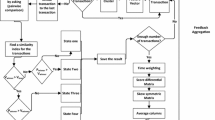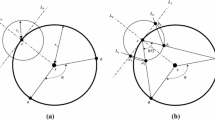Abstract
Aiming at the problem of imprecise reputation evaluation caused by too much subjective and qualitative evaluation of the traditional reputation evaluation model in data transactions, An Evaluation Entity-Based Reputation Evaluation model (EEBRE) is proposed. In order to realize multi-dimensional reputation evaluation, the structure of the evaluation entity is proposed to dynamically obtain the reputation data of the trading parties; a reputation evaluation assembly method combining objective indicators and feedback rating indicators is proposed, which replaces the qualitative scoring of data set quality indicators with quantitative scoring, introduces the static individual information indicators as well as transaction context attribute indicators, such as transaction amount, time, etc., and retains the qualitative evaluation of the feedback ratings to provide an interactive experience feedback pathway for the data requesting party. The experimental results show that the EEBRE model proposed in this paper can safely and effectively evaluate the seller’s reputation.












Similar content being viewed by others
Data availability
The datasets generated during and/or analyzed during the current study are available in the figshare repository, https://doi.org/10.6084/m9.figshare.23819655[37]
References
Jones CI, Tonetti C (2020) Nonrivalry and the economics of data. Am Econ Rev 110:2819–2858. https://doi.org/10.1257/aer.20191330
Dai W et al (2020) Sdte: a secure blockchain-based data trading ecosystem. IEEE Trans Inf Forensics Secur 15:725–737. https://doi.org/10.1109/TIFS.2019.2928256
Zheng L et al (2017) Customized data plans for mobile users: feasibility and benefits of data trading. IEEE J Sel Areas Commun 35:949–963. https://doi.org/10.1109/jsac.2017.2679661
Nguyen L et al (2021) Modeling and analysis of data trading on blockchain-based market in iot networks. IEEE Internet Things J 8:6487–6497. https://doi.org/10.1109/jiot.2021.3051923
An B, Xiao M, Liu A, Xu Y, Zhang X, Li Q (2021) Secure crowdsensed data trading based on blockchain. IEEE Trans Mob Comput 22:1763–1778. https://doi.org/10.1109/tmc.2021.3107187
Cheng HK et al (2020) Can gold medal online sellers earn gold? the impact of reputation badges on sales. J Manag Inf Syst 37:1099–1127. https://doi.org/10.1080/07421222.2020.1831776
Song S et al (2005) Trusted p2p transactions with fuzzy reputation aggregation. IEEE Internet Comput 9:24–34. https://doi.org/10.1109/MIC.2005.136
Nwebonyi FN, Martins R, Correia ME (2018) Reputation based approach for improved fairness and robustness in p2p protocols. Peer-to-Peer Network Appl 12:951–968. https://doi.org/10.1007/s12083-018-0701-x
You W et al (2011) Reputation inflation detection in a chinese c2c market. Electron Commer Res Appl 10:510–519. https://doi.org/10.1016/j.elerap.2011.06.001
Priyanka T et al (2015) Web service recom-mendation systems with reputation evaluation and malicious feed-back estimation prevention. Int J Res Comput Appl Robot 3(3):230–235
Zou B et al (2014) Social recommendations based on user trust and tensor factorization. J Softw 25:2852–2864. https://doi.org/10.13328/j.cnki.jos.004725
Xiong Y, Fu X (2024) User credibility evaluation for reputation measurement of online service. Int J Web Info Syst 20:176–194. https://doi.org/10.1108/IJWIS-12-2023-0247
Guo HH, Jiang JH, Cai H (2009) Modeling for reputation computing in c2c communities. Chin J Manage 6(8):1056–1060
Wang C et al (2014) Trust evaluation model based on reputation for c2c e-commerce. Comput Eng Appl 50(17):120–124244
Liu Y, Zhou X, Yu H (2021) 3r model: a post-purchase context-aware reputation model to mitigate unfair ratings in e-commerce. Knowl-Based Syst 231:107441. https://doi.org/10.1016/j.knosys.2021.107441
Wang C et al (2021) Factors influencing consumers’ purchase decision-making in o2o business model: evidence from consumers’ overall evaluation. J Retail Consum Serv 61:102565. https://doi.org/10.1016/j.jretconser.2021.102565
GAN Z-B et al (2011) Reputation-based multi-dimensional trust algorithm: Reputation-based multi-dimensional trust algorithm. J Softw 22:2401–2411. https://doi.org/10.3724/sp.j.1001.2011.03909
Hu D et al (2021) A blockchain-based trading system for big data. Comput Netw 191:107994. https://doi.org/10.1016/j.comnet.2021.107994
Ji S, et al. (2016) An anti-attack model for centralized c2c reputation evaluation agent. In 2016 IEEE International Conference on Agents (ICA), 63–69, https://doi.org/10.1109/ICA.2016.023
Zhang Y et al (2015) Evaluation model of buyers-dynamic reputation in e-commerce. Int J Multimed Ubiquitous Eng 10:53–64. https://doi.org/10.14257/ijmue.2015.10.5.07
Tang M et al (2017) Towards a trust evaluation middleware for cloud service selection. Futur Gener Comput Syst 74:302–312. https://doi.org/10.1016/j.future.2016.01.009
Ding S et al (2014) Combining qos prediction and customer satisfaction estimation to solve cloud service trustworthiness evaluation problems. Knowl-Based Syst 56:216–225. https://doi.org/10.1016/j.knosys.2013.11.014
Li X et al (2019) Enhancing cloud-based iot security through trustworthy cloud service: An integration of security and reputation approach. IEEE Access 7:9368–9383. https://doi.org/10.1109/access.2018.2890432
Aaltonen A, Alaimo C, Kallinikos J (2021) The making of data commodities: data analytics as an embedded process. J Manag Inf Syst 38:401–429. https://doi.org/10.1080/07421222.2021.1912928
Teh HY, Kempa-Liehr AW, Wang KIK (2020) Sensor data quality: a systematic review. J Big Data 7:11. https://doi.org/10.1186/s40537-020-0285-1
Li Z et al (2022) The analysis of two-way e-commerce credit evaluation model based on the c2c mode. J Glob Inf Manag 30:1–21. https://doi.org/10.4018/JGIM.305238
Li Y, Chen L (2020) Risk evaluation for c2c e-commerce via an improved credit counting method. Int Technol Lett 4:222. https://doi.org/10.1002/itl2.222
Wu F, Li HH, Kuo YH (2011) Reputation evaluation for choosing a trustworthy counterparty in c2c e-commerce. Electron Commer Res Appl 10:428–436. https://doi.org/10.1016/j.elerap.2010.09.004
Li C, Liang C (2012) Multi-dimensionality reputation evaluation model for c2c e-commerce. Chin J Manage 9(2):204–211
Liang X, Xiao J (2023) Dual channel based on blockchain and consumer sensitivity supply chain pricing and channel selection. Chin J Manage Sci 31:29–38. https://doi.org/10.16381/j.cnki.issn1003-207x.2020.1755
Kim J, Lennon SJ (2013) Effects of reputation and website quality on online consumers’ emotion, perceived risk and purchase intention. J Res Interact Mark 7:33–56. https://doi.org/10.1108/17505931311316734
Liu J, Wang M (2019) Practice of data quality evaluating index construction under big data. Comput Technol Develop 29(10):46–50
Tadelis S (2016) Reputation and feedback systems in online platform markets. Annu Rev Econ 8:321–340. https://doi.org/10.1146/annurev-economics-080315-015325
Li L, Tadelis S, Zhou X (2016) Buying reputation as a signal of quality: evidence from an online marketplace. Rand J Econ 51:965–988. https://doi.org/10.1111/1756-2171.12346
Wang J, Shan F, Zhang Y (2021) Research on the effectiveness of reputation mechanism of e-commerce platforms and research on credit supervision-evidence from taobao and jingdong. Collect Essays Financ Econ 269:103–112. https://doi.org/10.3969/j.issn.1004-4892.2021.02.010
Xu Y et al (2018) Optimal control of an online reputation dynamic feedback incentive model. Commun Nonlinear Sci Numer Simul 63:1–11. https://doi.org/10.1016/j.cnsns.2018.03.005
Cao L (2023) Data used and generated in data transactions. Figshare. https://doi.org/10.6084/m9.figshare.23819655
Funding
This research was supported by the Natural Science Foundation of Shandong Province, research on Key Technologies of Dynamic Game Access Control based on Blockchain, fund number ZR2020MF029, and the Natural Science Foundation of Shandong Province, fund number ZR2020MF058.
Author information
Authors and Affiliations
Contributions
All authors contributed to the study conception and design. Material preparation, data collection and analysis were performed by Li Cao, Yilong Gao and Bin Zhao. The first draft of the manuscript was written by Li Cao and all authors commented on previous versions of the manuscript. All authors read and approved the final manuscript.
Corresponding author
Ethics declarations
Conflict of interest
The authors declare no conflict of interest.
Additional information
Publisher's Note
Springer Nature remains neutral with regard to jurisdictional claims in published maps and institutional affiliations.
Rights and permissions
Springer Nature or its licensor (e.g. a society or other partner) holds exclusive rights to this article under a publishing agreement with the author(s) or other rightsholder(s); author self-archiving of the accepted manuscript version of this article is solely governed by the terms of such publishing agreement and applicable law.
About this article
Cite this article
Zhao, B., Cao, L. & Gao, Y. The data transaction reputation evaluation model based on evaluation entity. J Supercomput 80, 25377–25402 (2024). https://doi.org/10.1007/s11227-024-06415-z
Accepted:
Published:
Issue Date:
DOI: https://doi.org/10.1007/s11227-024-06415-z




